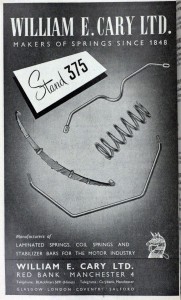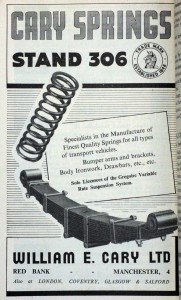Category Archives: 09. Rear axle
Wire wheels: worn hub and wheel splines
Wire wheels on Jaguar XKs
All Jaguar XK’s of the Special Equipment version were supplied with 16” wire wheels starting 1951. Also standard cars could have wire wheels as a factory option from that moment onwards.
 Early Rudge Whitworth wire wheel
Early Rudge Whitworth wire wheel
Wire wheel fixation
Detachable wire wheels have a different way of fixation compared to normal disc wheels, as they are mechanically “connected” to the axle hubs in two ways:
1. In a rotational direction by means of driving splines (serrations) on the (stub) axle hubs and driven splines on the inner wheel centre.
2. In an axial way by means of a (threaded) locking nut preventing the wheel to become disconnected from the threaded axle hub.
This article will not tackle the subject of which wire wheel types have been applied by Jaguar over the years; see the appropriate literature for that. We do want, however, to emphasise the potential danger of wire wheel fixation systems after many years of use (and abuse) to the point where they may become even highly dangerous! In addition, some guidance is provided in checking whether a wire wheel can still be safely fixed to the car.
A – Locking thread on hub (left or right hand thread).
B – Driving splines on hub.
E – Driven splines of wheel centre.
Rudge-Whitworth fixation
The system of detachable and interchangeable wire wheels has been initially designed by John Pugh around 1910 but is better known under the (company) name of Rudge-Whitworth.
The resulting standardisation of detachable wire wheel fixations in Europe dates back to the 1920’s. The basis for this standard was the load to be carried per wheel and the required bearing diameter for that, resulting in a certain cross section for the hub. Note that the wheel type designation in the standard are basically structured around the (metrical!) dimensions of (then available) wheel bearings.
![clip_image002[6] clip_image002[6]](https://www.bobine.nl/jaguar/wp-content/uploads/2014/05/clip_image0026_thumb.gif) Very early 1912 advertisement
Very early 1912 advertisement
Wear on splines and thread
Over the years the thread of the locking nut and the hub itself may wear but (even more important) the splines on the hub and in the wire wheel centre may wear to the extent that the construction eventually becomes unsafe. Therefore it is wise to regularly check them and more in particular during any XK restoration as the condition and history of axle hubs and wheels are unknown.
Four dimensions are of importance here and have to be checked:
1. The maximum allowed inner diameter of the thread of the lock nut
2. The minimum allowed outer diameter of the thread on the wheel hub
3. The minimum allowed outer diameter of the splined hub
4. The maximum allowed inner diameter of the inner wheel centre splines
Please note that wear of splines and thread is accelerated if the wheel is not fitted tightly!
Cross-section of Rudge-Whitworth hubs
The principle wheel type designation according the Rudge-Whitworth standard refers to the maximum size of an outer wheel bearing (in millimetre) which can be used with that hub. The actual hub diameter is measured across the outside of the splines on the axle hubs ( not the wheel splines).
|
Wheel Type |
Actual hub diameter |
Number of splines |
Spline length Short Hub |
|
35 |
52 |
62 |
36 |
|
42 |
62.5 |
75 |
37 |
|
52 |
73 |
88 |
37 |
|
62 |
82.5 |
100 |
57 |
|
72 |
92 |
112 |
55 |
|
80 |
102 |
124 |
58 |
|
90 |
111.5 |
136 |
56 |
|
100 |
123 |
150 |
59 |
|
120 |
137 |
168 |
63 |
Two wire wheel types are normally used on British sports cars: type 42 and 52. Jaguar opted for their post-war cars for the Type 52 wire wheels. The (course) thread of Jaguar wire wheels has a top angle of 60° and a pitch of 8 TPI (or 3.2 mm).
 Rear wheel splined hub Jaguar XK 140
Rear wheel splined hub Jaguar XK 140
Dimensional requirements for Type 52 wire wheels: worn or still OK?
Further to the aforementioned important testing criteria, the survey below gives specific information regarding when a splined hub, wire wheel or locking nut should be replaced.
- The locking nut should be checked for wear on the (internal) thread. If a cylinder with an outside diameter of 2.627” or 66.7 mm should fit in the locking nut, wear has progressed to the extent that the locking nut has to be replaced.
- If a tube with an internal diameter of 2.707” or 68.8 mm fits over the thread of the axle hub, wear has progressed to the extent the complete hub has to be replaced.
- If a tube with an internal diameter of 2.840” or 72.1 mm fits over the splines of the axle hub, the complete hub has to be replaced.
- If a cylinder with an outer diameter of 2.790” or 70.9 mm fits in the internally splined wheel centre, the complete wire wheel has to be replaced.
Note that the above dimensional requirements are no more than minimum requirements! As an example: wire wheel constructions fulfilling the above requirements have a remaining overlapping contact height of the splines of no more than (72.1 – 70.9 =) 1.2 mm. Although the contact surface is of course larger due to the 60° V angle of the spline and the length of the spline (here 37 mm), in comparison a new type 52 spline has a contact height of 72.9 – 70.2 = 2.7 mm, meaning that the (safety?) margin has been more than halved.
So don’t use any hubs or wheels with spline dimensions below the above given minimum requirements!
Rear leaf springs for XKs
Four different sets of rear springs have been used throughout the production of the Jaguar XK. All springs were of the semi-elliptical type and consisted of 7 bended leaves, the strength and thickness of which varied over the years.
 Typical XK rear suspension spring
Typical XK rear suspension spring
1. XK 120
1.1. The XK 120 started with rear suspension leaf springs (Jaguar part number C3661) which consisted of 3 leaves 7/32″ thick and 4 leaves 3/16″ thick.
1.2. With the introduction of the XK 120 Special Equipment (SE or MC) models the road springs became stiffer by increasing the number of 7/32″ thick leaves from 3 to 5 and reducing the 3/16″ thick leaves from 4 to 2. This second version leaf spring was now coded C5721.
1.3. This new spring became the standard for all XK120s by November 1952 from chassis numbers 661040/673320 and 669003/680397 onwards till the end of production.
2. XK140
2.1. All XK140s had the same set of springs which was in fact the continued XK120 SE version with code C5721.
3. XK150
3.1. The XK150 received an updated spring coded C13006 which was basically the continued XK120/XK140 set of leaf springs (C5721) but with a different mounting to the chassis with new rubber bushes and also rubber buttons at the end of the springs.
3.2. Because of the increasing kerb weight of the XK150 July 1958 saw the introduction of the fourth version of rear suspension leaf springs coded C14476 . The differences were twofold: one of the 7/32″ thick leaves was replaced by a stiffer ¼“ thick leaf and a nylon sheet (Jaguar name: “Interleaf”) was placed between the top and the second leaf. This meant that next to the ¼“ thick leaf there were now only 4 leaves 7/32″ thick and 2 leaves 3/16″ thick. This set of springs was interchangeable with the previous version C13006.
Leaf spring composition:
|
XK 120 (SE) and XK 140 |
XK 150 (S) |
||
|
C3661 |
C5721 |
C13006 |
C14476 |
|
1 leaf ¼“ thick |
|||
|
3 leaves 7/32” thick |
5 leaves 7/32” thick |
5 leaves 7/32” thick |
4 leaves 7/32” thick |
|
4 leaves 3/16” thick |
2 leaves 3/16” thick |
2 leaves 3/16” thick |
2 leaves 3/16” thick |
External markings:
Next to the part number and date code the manufacturers name and logo is stamped on the lower leaf spring. The company logo shows the words “Registered Trade Mark” and a horse head, followed by the name Wm E. Cary Ltd.
The three examples below show a XK 120 spring from 1953, a XK 140 spring from 1954 and a (original) replacement leaf for the XK 120/140 from 1962.
Replacement springs
As the leaf springs lose their strength over the years the car body drops sometimes up to 2 inches. But also leafs may break after some decades. Replacements are available and can be used without too many problems.
The finish of most replacement springs is not up to the same level as the original ones: e.g. no tapered ends of the leaves and many burrs. In addition the brackets that hold the leaf package together sometimes have some “play” which is not the case with the original springs. It may be worthwhile to disassemble these new springs and rework the spring ends and use new brackets with a better fit.
 Bracket holding leaves
Bracket holding leaves
As the original product code and manufacturers logo is stamped in the lower leaf and this leaf has the lowest contribution to the overall stiffness of the complete spring, it is a nice idea to re-use that leaf in the new spring assembly. It requires to remove the aforementioned brackets that hold the leaves together which allows you at the same time to add the nylon “Interleaves” between the top and second leaf (or even more if you want). Any good quality nylon 0.3 to 0.5 mm thick sheet will do. Other similar strong and durable or wear-resistant plastic can be used as well.
Manufacturer of original Jaguar leaf springs.
The original supplier of the leaf springs is the company William E. Cary Ltd of Manchester. This company supplied to various car manufacturers, not only the leaf springs but also torsion springs and other stampings. See also the adds below.
![clip_image002[4] clip_image002[4]](https://www.bobine.nl/jaguar/wp-content/uploads/2014/05/clip_image0024_thumb.gif)

![clip_image002[4] clip_image002[4]](https://www.bobine.nl/jaguar/wp-content/uploads/2014/01/clip_image0024_thumb.jpg)




